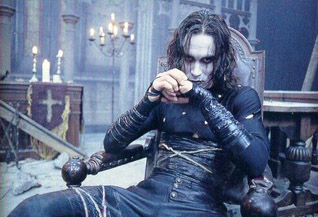|
|
Viking Night: The CrowBy Bruce HallAugust 3, 2010
Music is a huge part of The Crow’s style and the soundtrack’s dour mix of hard rock, Gothic and industrial tunes propels the story as much as anything that happens on screen. If watching Draven apply his evil clown make-up to the moody strains of The Cure’s “Burn” doesn’t give you a charge, then you just might be dead yourself. Likewise, the visual design of The Crow at times makes it feel like an extended music video; creative use of miniatures and early digital effects was partially out of necessity but it also served to give the film a distinctive appearance. The iconic scenes of a lone crow soaring over the rust colored cityscape of Detroit (yes, it’s Detroit) reinforce the universal nature of Loss, and remind us that the pain Draven is experiencing could happen to any one of us (laugh at me if you want, but that actually was the intent). The skyline below is comprised of obvious miniatures but they’re so lovingly detailed and meticulously crafted that the effect is not distracting – it’s actually seamless in a way, and quite breathtaking. And having seen more than a few Godzilla movies in my time, ‘breathtaking’ is not normally a word I associate with miniatures. But the most important aspect of The Crow, and the one that makes the story – thin as it is – so effective is the persistent idea that love and loyalty can overcome any obstacle and motivate any of us to achieve things that we never felt were possible. These sentiments are as old as humanity itself but they aren’t the sort of thing you often find in a revenge tale, let alone one with this level of violence. The characters, both good and evil, are intertwined in a meaningful way that isn’t apparent at first, but makes everything that happens to them seem preordained once the end credits roll.
|

|
|
|

|
Friday, November 1, 2024
© 2024 Box Office Prophets, a division of One Of Us, Inc.


